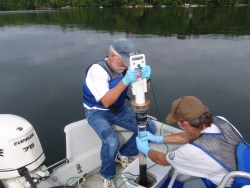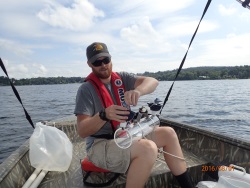Lake and Pond Water Quality Monitoring
The DEEP Water Monitoring Program conducts ambient monitoring and the related assessment of the State’s waters, including Connecticut's many lakes and ponds. In Connecticut, there are a total of 2,267 lakes and ponds greater than 10 acres in size. The Monitoring Program conducts annual monitoring on approximately 10-20 of these. The type and locations of monitoring during a given year is determined by a variety of factors including participation in regional and national studies as well as support requests from groups within DEEP.



Program Background
DEEP has conducted a range of lake monitoring efforts since the 1990s. During early efforts, Connecticut DEEP assessed approximately 100 significant lakes statewide for CWA 305(b) reporting. Significance was based on a lake having state or federal public access, or providing unique or otherwise important habitats. In 2002, lake monitoring and assessment efforts expanded to include previously listed 303(d) waters (e.g. 'impaired waters'). As a result of this expanded effort, a number of lakes and ponds not previously considered significant, but believed to have impairments, were added to the lake assessment list.
In 2005, DEEP's Ambient Monitoring Strategic Monitoring Plan identified a number of lake studies to be undertaken over a five-year period. The objectives of the studies were to determine the trophic conditions of the State’s inland lakes, identify waters that are of high quality, identify those waters not meeting the State’s water quality standards, determine if water quality is changing over time, identify emerging issues/problems, and to support DEEP lake watershed management programs. The projects and objectives outlined in the 2005 plan formed the foundation of the current lake and pond water quality monitoring program in Connecticut.
Current Lake and Pond Monitoring Efforts
To-date DEEP has assessed nearly 200 lakes statewide for Clean Water Act 305(b) reporting and lake monitoring. Beginning in 2006, participation in several nationally-coordinated lake studies (see below) resulted in a notable additional increase in the number of lakes assessed annually. In addition, between 2005-2007, DEEP collaborated with Connecticut College on a project that sampled 60 lakes throughout Connecticut.
The DEEP Water Monitoring Program participates in the USEPA’s National Lakes Assessment (NLA) probabilistically based surveys. The goals of this monitoring project are to assess the condition of lakes nationally by determining what percentage of the lakes are in good, fair, and poor condition based on trophic, ecological, and recreational indicators. In addition, these data can be used for state assessments, to determine the importance of key stressors, establish a baseline for future monitoring of lakes, to assess trends in lake status in the past three decades, and to help build state and tribal capacity for monitoring and assessment programs. Lakes are sampled for a variety of limnological, biological, and physical habitat parameters.
The following is a list of lakes monitored in Connecticut to-date as part of National Lakes Assessment surveys.
| Lake/Pond Name |
2007 |
2012 |
2017 |
2022 |
| Beardsley Pond |
X |
X |
|
|
| Billings Lake (North Stonington) |
|
|
X |
X |
| Bissonette Pond |
X |
X |
X |
|
| Columbia Lake |
|
X |
|
|
| Crystal Lake (Winchester) |
|
|
|
|
| Deep Lake |
|
|
X |
|
| Grays Pond |
|
|
X |
|
| Groton Reservoir |
X |
|
|
|
| Halls Pond (Eastford) |
|
X |
X |
|
| Halls Pond (Willington) |
|
|
X |
X |
| Knowlton Pond |
X |
|
|
|
| Lake Chaffee (Ashford) |
|
|
|
X |
| Lake Kenosia |
X |
|
|
|
| Lake Waramaug |
X |
|
|
|
| Lake Zoar |
X |
|
X |
X |
| Long Meadow Pond |
|
X |
|
|
| Messerschmidt Pond |
|
X |
|
|
| Morris Reservoir |
X |
X |
X |
|
| Pachaug Pond |
X |
|
|
|
| Riga Lake |
X |
X |
X |
|
| Roseland Lake |
X |
X |
|
|
| Unnamed Lake (Durham) |
|
|
|
X |
| Union Pond |
X |
|
|
|
| Wauregan Reservoir (Quinebaug Lake) |
|
X |
|
|
| West Hill Pond |
X |
X |
X |
|
| Whites Pond (Suffield) |
|
|
|
X |
| Wononpakook Lake |
X |
|
|
|
| Wononscopmuc Lake |
|
|
|
X |
In 2007, sampling was also conducted from lakes in Connecticut under the New England Lakes and Pond Project (NELP). The NELP project was designed to evaluate the condition of the region’s water bodies as a population and to establish a baseline from which to compare future studies. It was a collaborative effort involving the United States Environmental Protection Agency (EPA), New England Interstate Water Pollution Control Commission (NEIWPCC), CT DEEP and other New England state environmental agencies, academic institutions, lake associations, and other stakeholders. The project utilized new lake assessment technologies and tested new methods, with the goal of making this information transferable to other monitoring programs. Although initiated in 2006, the NELP project was designed to integrate with the 2007 National Lakes Assessment (NLA) and provide opportunities for enhancing the spatial resolution and statistical confidence levels of lake results within the New England states.
Related DEEP Links:
Sources of Additional Information:
Program Contact Information
Water Monitoring and Assessment Program
79 Elm Street, Hartford CT 06106
DEEP.watermonitoring@ct.gov
Content last updated June 27, 2022.




